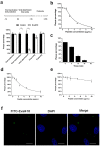Histidine-rich Modification of a Scorpion-derived Peptide Improves Bioavailability and Inhibitory Activity against HSV-1
- PMID: 29290802
- PMCID: PMC5743469
- DOI: 10.7150/thno.21425
Histidine-rich Modification of a Scorpion-derived Peptide Improves Bioavailability and Inhibitory Activity against HSV-1
Abstract
Rationale: HSV is one of the most widespread human viral pathogens. HSV-1 infects a large portion of the human population and causes severe diseases. The current clinical treatment for HSV-1 is based on nucleoside analogues, the use of which is limited due to drug resistance, side effects and poor bioavailability. AMPs have been identified as potential antiviral agents that may overcome these limitations. Therefore, we screened anti-HSV-1 peptides from a scorpion-derived AMP library and engineered one candidate into a histidine-rich peptide with significantly improved antiviral activity and development potential. Methods: A venomous gland cDNA library was constructed from the scorpion Euscorpiops validus in the Yunnan Province of China. Six putative AMPs were characterized from this cDNA library, and the synthesized peptides were screened via plaque-forming assays to determine their virucidal potential. Time of addition experiments according to the infection progress of HSV-1 were used to identify the modes of action for peptides of interest. The histidine-rich modification was designed based on structural analysis of peptides by a helical wheel model and CD spectroscopy. Peptide cellular uptake and distribution were measured by flow cytometry and confocal microscopy, respectively. Results: The peptide Eval418 was found to have high clearance activity in an HSV-1 plaque reduction assay. Eval418 exhibited dose-dependent and time-dependent inactivation of HSV-1 and dose-dependent inhibition of HSV-1 attachment to host cells. However, Eval418 scarcely suppressed an established HSV-1 infection due to poor cellular uptake. We further designed and modified Eval418 into four histidine-rich derivative peptides with enhanced antiviral activities and lower cytotoxicities. All of the derivative peptides suppressed established HSV-1 infections. One of these peptides, Eval418-FH5, not only had strong viral inactivation activity and enhanced attachment inhibitory activity but also had high inhibitory activity against intracellular HSV-1, which was consistent with its improved intracellular uptake and distribution as confirmed by confocal microscopy and flow cytometry. Conclusion: We successfully identified an anti-HSV-1 peptide, Eval418, from a scorpion venom peptide library and designed a histidine-rich Eval418 derivative with significantly improved potential for further development as an anti-HSV-1 drug. This successful modification can provide a design strategy to improve the bioavailability, cellular distribution and antiviral activity of peptide agents.
Keywords: Anti-HSV-1 peptides; Bioavailability.; Cellular uptake; Histidine-rich modification; Scorpion venom peptides.
Conflict of interest statement
Competing Interests: The authors have declared that no competing interest exists.
Figures






Similar articles
-
Scorpion-Derived Antiviral Peptides with a Special Focus on Medically Important Viruses: An Update.Biomed Res Int. 2021 Sep 4;2021:9998420. doi: 10.1155/2021/9998420. eCollection 2021. Biomed Res Int. 2021. PMID: 34527748 Free PMC article. Review.
-
Inhibitory activity and mechanism of two scorpion venom peptides against herpes simplex virus type 1.Antiviral Res. 2014 Feb;102:1-10. doi: 10.1016/j.antiviral.2013.11.013. Epub 2013 Dec 4. Antiviral Res. 2014. PMID: 24315793 Free PMC article.
-
Design of histidine-rich peptides with enhanced bioavailability and inhibitory activity against hepatitis C virus.Biomaterials. 2013 Apr;34(13):3511-22. doi: 10.1016/j.biomaterials.2013.01.075. Epub 2013 Feb 13. Biomaterials. 2013. PMID: 23415044 Free PMC article.
-
Virucidal activity of a scorpion venom peptide variant mucroporin-M1 against measles, SARS-CoV and influenza H5N1 viruses.Peptides. 2011 Jul;32(7):1518-25. doi: 10.1016/j.peptides.2011.05.015. Epub 2011 May 19. Peptides. 2011. PMID: 21620914 Free PMC article.
-
Antimicrobial peptides from scorpion venoms.Toxicon. 2014 Sep;88:115-37. doi: 10.1016/j.toxicon.2014.06.006. Epub 2014 Jun 19. Toxicon. 2014. PMID: 24951876 Free PMC article. Review.
Cited by
-
The Scorpion Venom Peptide Smp76 Inhibits Viral Infection by Regulating Type-I Interferon Response.Virol Sin. 2018 Dec;33(6):545-556. doi: 10.1007/s12250-018-0068-4. Epub 2018 Dec 19. Virol Sin. 2018. PMID: 30569290 Free PMC article.
-
Antimicrobial peptides: natural or synthetic defense peptides against HBV and HCV infections.Virusdisease. 2022 Dec;33(4):445-455. doi: 10.1007/s13337-022-00790-y. Epub 2022 Nov 10. Virusdisease. 2022. PMID: 36447811 Free PMC article. Review.
-
Scorpion-Derived Antiviral Peptides with a Special Focus on Medically Important Viruses: An Update.Biomed Res Int. 2021 Sep 4;2021:9998420. doi: 10.1155/2021/9998420. eCollection 2021. Biomed Res Int. 2021. PMID: 34527748 Free PMC article. Review.
-
Antimicrobial Activity Developed by Scorpion Venoms and Its Peptide Component.Toxins (Basel). 2022 Oct 28;14(11):740. doi: 10.3390/toxins14110740. Toxins (Basel). 2022. PMID: 36355990 Free PMC article. Review.
-
DRAVP: A Comprehensive Database of Antiviral Peptides and Proteins.Viruses. 2023 Mar 23;15(4):820. doi: 10.3390/v15040820. Viruses. 2023. PMID: 37112801 Free PMC article.
References
-
- Brandt C R. The role of viral and host genes in corneal infection with herpes simplex virus type 1. Experimental eye research. 2005;80:607–21. - PubMed
-
- Liashkovich I, Hafezi W, Kuhn J M, Oberleithner H, Shahin V. Nuclear delivery mechanism of herpes simplex virus type 1 genome. Journal of molecular recognition: JMR. 2011;24:414–21. - PubMed
-
- Schacker T. The role of HSV in the transmission and progression of HIV. Herpes: the journal of the IHMF. 2001;8:46–9. - PubMed
-
- Schang L M. Herpes simplex viruses in antiviral drug discovery. Current pharmaceutical design. 2006;12:1357–70. - PubMed
Publication types
MeSH terms
Substances
LinkOut - more resources
Full Text Sources
Other Literature Sources

